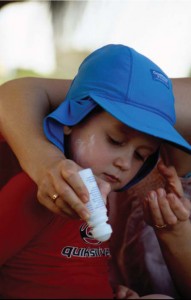 It’s tough to argue against using sunscreen as an important method of protection against sun damage to our skin. But what many consumers don’t realize is that some popular products (used religiously by us sun-loving Australians) also contain an array of chemicals that could make applying sunscreen to your skin more hazardous than sun exposure itself.
It’s tough to argue against using sunscreen as an important method of protection against sun damage to our skin. But what many consumers don’t realize is that some popular products (used religiously by us sun-loving Australians) also contain an array of chemicals that could make applying sunscreen to your skin more hazardous than sun exposure itself.
As the demand for sunscreen with higher sun protection factors (SPF) has increased over the years, the skin care industry has had to increase the level of chemical compounds found in these products.
Of particular concern are sunscreens that are specially developed for children. While as well-meaning parents slather our bubs with those “kid-friendly” lotions (look! It’s purple – what fun!), we also might want to take a closer look at the ingredient list.
In Australia most sunscreens are regulated as medicines under the Therapeutic Goods Act (TGA). However, products containing sunscreen ingredients classified as cosmetic are not regulated by the TGA and are not required to be tested for photocarcinogenic effects.
Here are some things to look out for:
Benzophenone (benzophenone-3), homosalate, and octy-methoxycinnamate (octinoxate): These chemicals are bad news because they have shown estrogenic activity in lab tests. Oxybenzone is a derivative of benzophenone and it is linked to allergies, hormone disruption, and cell damage. A study by the Center for Disease Control in the US found that 97 per cent of the 2,500 people tested aged six years and up had oxybenzone in their urine.
Parabens (butyl-, ethyl-, methyl-, and propyl-): Parabens are common in sunscreens so avoiding them may prove difficult. They are preservatives that have estrogenic qualities. They have produced abnormal hormonal effects following on laboratory rodents, particularly male, resulting in decreased testosterone levels and other abnormalities. They have also been found to accumulate in the breast tissue of women with breast cancer.
Padimate-O and Parsol 1789 (Avobenzone): While on the surface of the skin these chemicals appear to prevent UV damage but when absorbed into the skin they can actually damage DNA. There is evidence that the sun’s light may cause these chemicals to become reactive and cause free-radical damage when they’re absorbed.
If you are looking for safer sunscreen options there are some great products out there, and here are a few that I love:
Little Innoscents Sunscreen (SPF 30+)
The unique sunscreen formula from this Australian brand provides skin with essential UVA and UVB broad spectrum protection. It’s also free from nanoparticles or chemical absorbers, and contains aloe vera, vitamin E and calendula as a safe and natural alternative for sensitive skin
WotNot SPF 30+ Sunscreen
Made in Australia and provides broad spectrum protection against UV-B rays as well as UV-A.
California Baby SPF 30+ no-fragrance sunscreen
It’s also the WebMD Expert’s Choice Winner
And for more on the subject, click here for a paper from Dr Peter Dingle, an Australian environmental and nutritional toxicolgist.
Creative Communications, Graphic Design, Communications, Blogging, Copywriting, Content Management


